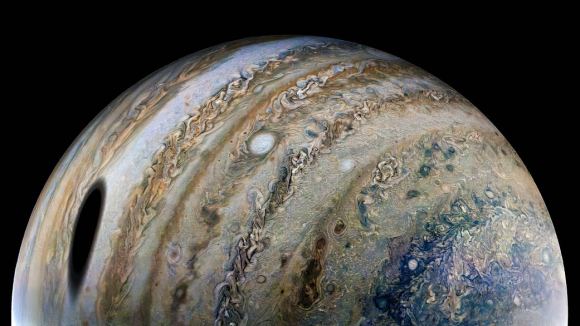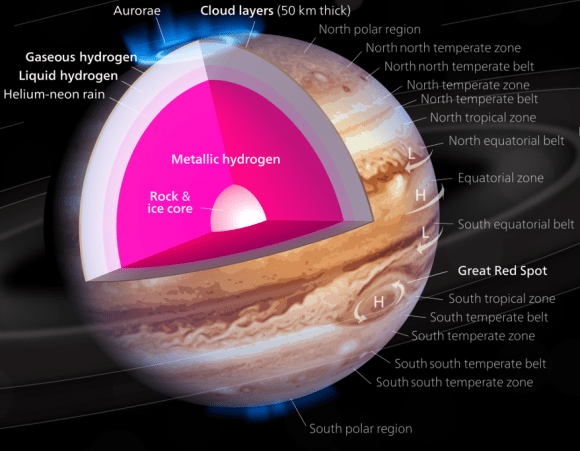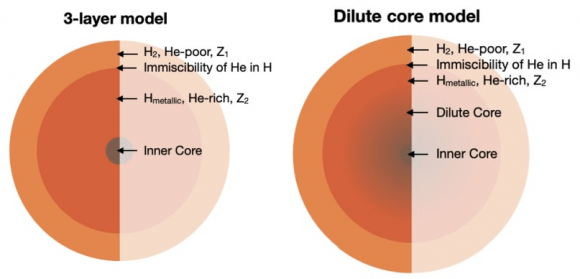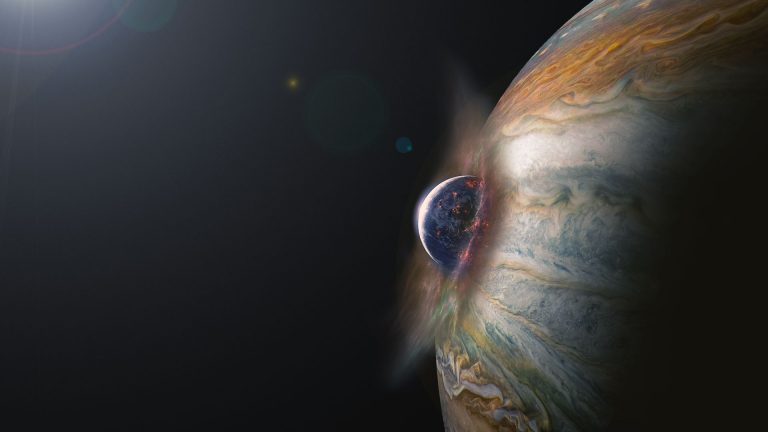NASA Unveils Jupiter’s Growth Through Early Consumption of Rocky Planetesimals
Jupiter is basically composed of four basic elements namely hydrogen, helium, and trace amounts of other elements like methane, ammonia and water. The ratios of both approximately correspond to the anticipated original abundances in the solar nebula. It does, however, contain more massive particles known as metal elements than the nonmetals. Although trace amount of metals are present in Jupiter, let alone have volume, their existence and distribution comes as useful data for scientists.
In a study conducted recently, it pointed out that the metallic nature and the extent of metallic distribution within Jupiter points to the fact that it was built from an extensive number of solid silicate planetesimals.
Since July 2016, Juno – a space probe belonging to NASA – has helped to accumulate a large amount of information concerning the formation and development of Jupiter. Among the instruments showcased in the mission, the most notable is the Gravity Science experiment.
It relays radio signals between Juno and the ground base of Deep Space Network. The procedure helps to track changes in the field of gravity near Jupiter and gives additional data for researchers on the composition of the planet.

Jupiter grew by accumulating the planetesimals and other rocky materials that were present in the solar system. After that there was rapid increase of mass of gas from the solar nebula and that made the Jupiter the monster it is now. However, there is a significant controversy concerning the early time period of the buildup of rocky materials. Did it accrue more massive of rocks, like planetesimals?Or did it gain pebble-sized particles?Jupiter developed over time and at different time periods depending on the reception it received.
This is a question that was answered by a recent study. The published work entitled “Jupiter’s inhomogeneous envelope” appears in the Astronomy and Astrophysics online edition. Yamila Miguel is the primary author of the study, and she is an Assistant Professor of Astrophysics at Leiden University and the Netherlands Institute for Space Research, Leiden Observatory.
By now, one has come across visually appealing images of Jupiter that have been captured by the Juno spacecraft’s JunoCam.
However, this is not the reality of the perceptions we have; in actuality, we only observe what is on the surface. Most of those stunning looks at clouds and storms emanate from the final 50 kilometers (31 miles) of the planet’s atmosphere. Jupiter’s creation and its early stages must be buried miles deep within the thousands of kilometers through the gas giant’s atmosphere.

Jupiter is often referred to as the oldest planet in the solar system when in fact it is just another planet. However, scientists are yet to find out the time that was taken to make it.
The researchers conducting the study wanted to study the metals in the atmosphere of the planet using Juno’s Gravity Science instrument. Pebbles exist within Jupiter and are significant to the formation and formation of the giant planet, and the experiment known as the Gravity Science aimed to study the distribution of the pebbles within the atmospheric layer of the gaseous environment of the gaseous planet. Jupiter gravity harmonics were unknown prior to Juno and the Gravity Science mission cooperative research study.
The researchers also found out that Jupiter’s atmosphere, not nearly as uniform as once proposed. This layer is composed of more metals as you approach the centre of the planet than it is in the other layers. In total the metals amount to $M_{total}$ which is between 11 and 30 times the mass of earth.
With the given data, the researchers modeled the geological processes within Jupiter. The scientists said: “In this paper, we calculate the set of Jupiter interior models including both the most up-to-date and diverse and then employ the set to investigate of heavy elements in the planet’s envelope.
”In order to trial the model, the team derived two sets of models. The first boost collection contains 3-layer models whereas the second boost collection contains dilute core models.

“There are two mechanisms for a gas giant like Jupiter to acquire metals during its formation: “by the incorporation of small gravels or by even larger bodies of planetesimals,” points out Miguel, the author of the study.
“It is a fact that after a certain size of new born planets they start to eject stones. Within Jupiter there are numerous metals which we see today could not have been produced before that stage.
So Jupiter could not have formed from pebbles alone. Planetesimals are too large to be shielded and therefore must have made an contribution. ”
Starting from the core of Jupiter, the quantity of metals reduces gradually as one moves away from the nucleus. That is suggestive of the absence of convection in the deep atmosphere of the planet, something that scientists assumed existed. “Earlier, we used to believe like Jupiter used to have convection or boiling water kind of motion which makes the whole thing well mixed,” Miguel said.“However, from this research, it is evident that this is not the case. ”
“We strenuously showing that the abundance of heavy element is not constant in the envelope of Jupiter,”
the authors of the study note. “Thus, our findings suggest that Jupiter formed from a circumstellar disk during the growth of the hydrogen-helium envelop, in contradiction with the simple pebble-isolation mass, if one assumes the planetary core accretion model, supporting either the planetesimal-based model or the more complex hybrid option.

The authors also note that convection failed to mix Jupiter after its formation process despite the fact that at that age, the giant planet was still hot.
The team’s findings also prove useful when it comes to understanding how gaseous exoplanets can be searched for metal content. “Our result … provides a base example for exoplanets: a non-uniform outer shell means that the metallicity detected is actually a minimum to the planetary body’s overall metallicity. Jupiter’s metallicity could not be directly measured from a distance.
It means that the determination of metallicity was possible only after the landing of Juno and even then it was indirect. “Thus, metallicities obtained from remote spectroscopic sensing of the planetary atmospheres in exoplanets may not necessarily reflect the bulk metallicity of the planet. ”When operations commence for JWST, one of its responsibilities will be to characterize and quantify the atmospheric makeup of exoplanets.
This analysis shows that Webb will not be able to detect what lies in the inner most layers of large gas planets.
Do not forget to share your opinion with us to provide you with the best posts !




0 Comments